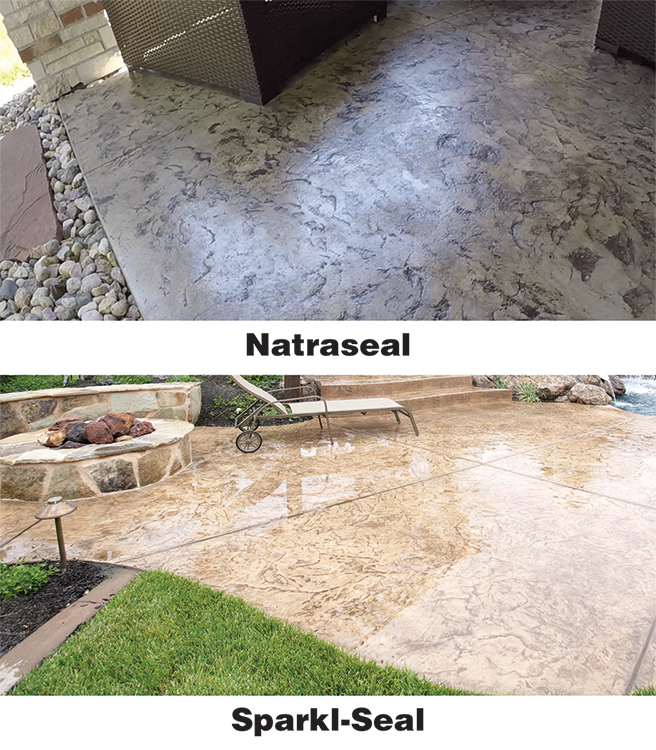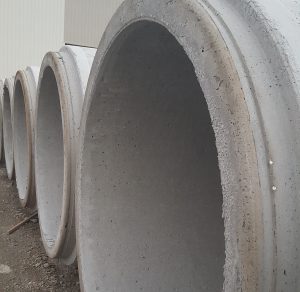Nox-Crete now offers Freeze Protection shipping for 5-gallon pails and 1-gallon jugs, which allows us to ship small orders of water-based products in freezing conditions.
Yearly Archives: 2016
Chembeton Gives Customers What They Want: an Economical, High-Quality Release Agent
End users and distributors alike want best-in-class release agents, but they want them at a lower cost. Over the past 60 years, Nox-Crete has learned a thing or two about manufacturing best-in-class chemical solutions to concrete problems.

Chembeton provides a crisp, positive release, along with a cleaner, smoother appearance than competing release agents. Chembeton was used on the two panels in the foreground.
What you might not know is that our family of release agents features high-performance products at all price points—including Chembeton.
Providing the greatest value and a high level of performance, Chembeton is ideal for plywood-faced handset forms, B-B plywood, steel and aluminum, and forms previously treated with form oil.
Chembeton is a hybrid form release agent that combines both chemically active and barrier-type release properties for a crisp, positive release. Its petroleum-based formulation also allows for easy spraying in cold weather.
Chembeton provides many advantages, including:
- Dries fast
- Resists wash-off
- Mild odor
- Can be applied up to three weeks before concrete pour
- Is ready to use, no dilution required
- Provides a crisp, positive release
-
Reduces cleaning and maintenance costs–forms become self-cleaning with continued use
-
Resists removal by foot traffic and rain
-
Can be used on forms that have been previously treated with competitive form oils
- One grade for year-round sprayability
-
Surpasses performance requirements of US Army Corps of Engineers, GSA and Bureau of Reclamation specifications for nonstaining form oil
-
Meets all federal, state and Canadian VOC requirements (excludes SCAQMD of California)
Learn more about how Chembeton is right for you by contacting Nox-Crete's customer service team at 402.341.2080 and by reading the product data sheet.
Properly Removing Bondbreaker from Concrete Can Help Cut Potential of Tilt-Up Floor Sweating
by Craig Coppersmith, P.E., VP Technical Sales & Marketing
Nox-Crete strives to create the highest quality chemicals for the concrete industry, and to consult with architects, engineers, contractors and distributors regarding the use of our products and their impact on the maintenance of concrete. Our goal is to ensure that those products enhance both the performance and appearance of concrete floors.
Recently, there has been much discussion in the concrete construction industry regarding the phenomenon of sweating floor slabs (commonly referred to as Sweating Slab Syndrome) in warehouses and distribution centers. There are multiple factors that have been suggested to contribute to Sweating Slab Syndrome, including trace amounts of reactive bondbreaker that may remain on floors in casting areas.
Understanding and sharing in the concerns about Sweating Slab Syndrome, the Nox-Crete team set out to verify that our Silcoseal Cure and Bondbreaker could be effectively removed from a tilt-up floor following our standard recommendations for removal, which is cited in our product data sheets. This would validate our recommended processes for removal of Silcoseal Cure and Bondbreaker and eliminate it as a possible contributor to the Sweating Slab Syndrome, by virtue of a proven method for its removal.
To demonstrate that Silcoseal Cure and Bondbreaker  could be effectively removed, Nox-Crete contracted with Nelson Testing Laboratories (NTL)—an independent, certified testing agency—to perform a mock tilt-up using Silcoseal Cure and Bondbreaker and Nox-Crete’s citrus-based stripper, Bio-Clean Concentrate CPC, for the removal.
could be effectively removed, Nox-Crete contracted with Nelson Testing Laboratories (NTL)—an independent, certified testing agency—to perform a mock tilt-up using Silcoseal Cure and Bondbreaker and Nox-Crete’s citrus-based stripper, Bio-Clean Concentrate CPC, for the removal.
Analysis Process
NTL mixed and poured concrete into a 9-foot x 4-foot x 2-inch thick mold. The concrete surface was finished with a steel trowel and coated with two coats of Silcoseal Cure and Bondbreaker, applied at 400 sf/gallon, 24 hours apart. After another 24 hours, a concrete wall panel was cast on top of the original concrete specimen. After another 48 hours, the wall panel was separated from the original concrete specimen.
The exposed face of the concrete casting surface was then sectioned into three equal parts: uncleaned; cleaned with Bio-Clean diluted 1:3 with water; and cleaned with Bio-Clean diluted 1:5 with water.
The uncleaned sample was left untouched. The area cleaned with Bio-Clean diluted 1:3 was stripped with a 1:3 ratio of Bio-Clean Concentrate CPC to water solution, using a nylon scrub brush simulating a downward force of 100 pounds. The area cleaned with Bio-Clean diluted 1:5 was stripped with a 1:5 ratio of Bio-Clean Concentrate CPC to water solution, using a nylon scrub brush simulating a downward force of 100 pounds.
Four 50-gram samples were then extracted from the concrete casting surface—plain concrete; concrete exposed to Silcoseal Cure and Bondbreaker but not stripped with the Bio-Clean solution; concrete exposed to Silcoseal Cure and Bondbreaker and stripped with the 1:3 Bio-Clean solution; and concrete exposed to Silcoseal Cure and Bondbreaker and stripped with the 1:5 Bio-Clean solution.
Methods of Analysis
The four pulverized concrete samples were chemically extracted with η-hexane. To remove all organic substances, 50 grams per each of the four samples were extracted.
The liquid extract from each of the four concrete samples and the liquid samples of the Silcoseal Cure and Bondbreaker and Bio-Clean Concentrate CPC were dried on a universal diamond Attenuated Total Reflectance Accessory (ATR) for Infrared Spectroscopy, then analyzed using a Perkin Elmer Spectrum Model One Fourier Transform Infrared (FTIR) Spectrometer, with a configuration of resolution of 4 cm-1 and eight accumulations (number of scans) per sample.
Samples Received for Analysis
Six samples were analyzed:
A) Bio-Clean Concentrate CPC (liquid sample)
B) Silcoseal Cure and Bondbreaker (liquid sample)
C) Plain concrete not exposed to Silcoseal (50 g. sample – pulverized concrete)
D) Concrete exposed to Silcoseal, not cleaned (50 g. sample – pulverized concrete)
E) Concrete exposed to Silcoseal, stripped with 1:3 ratio of Bio-Clean Concentrate CPC to water (50 g. sample – pulverized concrete)
F) Concrete exposed to Silcoseal, stripped with 1:5 ratio of Bio-Clean Concentrate CPC to water (50 g. sample – pulverized concrete)
Extraction and Infrared Spectroscopy Analysis Results
Evidence of the presence of Silcoseal Cure and Bondbreaker was not found in three of the pulverized concrete samples (Samples C, E & F). However, Sample D, the pulverized concrete that was exposed to Silcoseal but not cleaned, contained a detectable amount of organic extract, indicating the presence of Silcoseal─as expected.
Both of the stripping solution ratios (1:3 and 1:5) of Bio-Clean Concentrate CPC to water effectively removed the Silcoseal Cure and Bondbreaker.
The infrared spectra of both of the extracts from Samples E & F show a sharp absorption band around 1100 cm-1 (frequency), which is due to the presence of the Bio-Clean. Organic substances from the Silcoseal Cure and Bondbreaker are not evident in the spectra of Samples C, E & F, but are evident in Sample D.
Summary: Nox-Crete’s Interpretation of the Analysis Results
Proper surface preparation will remove all trace amounts of Silcoseal Cure and Bondbreaker and its heavy metallic soaps from concrete tilt-up floors. If no Silcoseal Cure and Bondbreaker residue remains on the tilt-up floor, it cannot contribute to Sweating Slab Syndrome.
NOTE:  These independent tests were only conducted on Nox-Crete-branded products. It is unknown whether other brands of reactive bondbreakers can be successfully removed.
These independent tests were only conducted on Nox-Crete-branded products. It is unknown whether other brands of reactive bondbreakers can be successfully removed.
The most effective way to remove Silcoseal Cure and Bondbreaker residue is with Nox-Crete’s Bio-Clean Concentrate CPC. Nox-Crete recommends taking these steps to remove bondbreaker residue from concrete floors:
- Dilute Bio-Clean Concentrate CPC 1:1 with water for stripping heavy coatings. For removal of lighter coatings,dilute with a ratio of 1:3.
- Uniformly apply by sprayer or through an automatic floor machine at an application rate of 200-300 sf/gal (5-7.5 sm/L).
- Allow product to dwell on the floor surface for 20-30 minutes while aggressively scrubbing the surface with an automatic floor machine equipped with nylon scrub brushes.
- Squeegee the surface clean and rinse thoroughly with water.
Follow these links to learn more about Nox-Crete's line of Silcoseal Cure and Bondbreakers and Bio-Clean Concentrate CPC, or call our customer service team at 402-341-2080.
High-Performance, Economical Dry-Cast Release Agent? Check!
Finding a high-performance, economical release agent for dry-cast used to be as likely as winning the lottery.
But Dry-Cast producers have just won the jackpot.
Nox-Crete Products Group is proud to announce that we have developed a release agent specifically formulated for pipe production: Dry-Cast Release, available now at a very competitive price.
Nox-Crete has proudly served the pipe, precast and prestressed concrete industries for 60 years, and Dry-Cast Release is the latest high-performance product to join our family of chemical solutions to concrete problems.
Our new, economical Dry-Cast Release formula has been tested and proven to give you an exceptionally clean and sharp finish, no residue build-up on pallets or headers and inherent biodegradability.
Dry-Cast Release has many advantages, including:
- Easy removal of pallet and header ring, minimizing damage and related patching and repair.
- Crisp release greatly minimizes chipping on spigot (tongue) ends at gasket recess.
- Minimizes form cleaning and maintenance costs – pallets and headers become self-cleaning with continued use.
- Non-staining.
- Does not impair the natural bonding characteristics of lubricating agents used on the bell end.
- Inherently biodegradable.
- Economically priced.
You can learn more about how Dry-Cast Release works and how to use it by taking a look at the product data sheet.
Please contact Precast Division Manager Jeff Bishop at 402-504-9228 or Precast Sales Manager Pat Linn at 402-504-9224 directly for more information or pricing.
Freshen up that Patio with Natraseal and Sparkl-Seal

Natraseal is a breathable, solvent-based, non-yellowing, transparent acrylic copolymer, decorative concrete sealer blended for maximum working time and easy application.
The clear sealer was designed to minimize common errors that can occur when applying traditional sealers, such as bubbles or whiting. Natraseal has longer working time than traditional 25% solids sealers and can be applied with a brush, roller or sprayer.
This new generation sealer uses top quality resins and a solvent blend that penetrates deep into the concrete surface for enhanced breathability and less ‘capping off’ of the pores. Combined with UV inhibitors, Natraseal minimizes potential whitening or yellowing.
Natraseal meets all Federal VOC requirements. It is not for use in Canada, California, LADCO or OTC States.
Before applying Natraseal, remove existing sealers with Nox-Crete’s Deco-Strip or Deco-Peel.
Sparkl-Seal is a premium acrylic sealer for decorative concrete that enhances surface colors with a glossy sheen while offering UV and wear protection. Sparkl-Seal penetrates and fills hairline micro cracks, increasing the integral strength of surfaces and creating a tough, non-yellowing acrylic coating over the surface that prevents spalling and freeze/thaw damage. The abrasion-resistant film also protects surfaces from absorption and damage from water, dirt, food, deicing salts, oil and grease.
Solvent-based, Spark-Seal and Sparkl-Seal LVOC create a high gloss finish that gives treated concrete surfaces a desirable ‘wet’ sheen. Water-based Sparkl-Seal E offers a medium gloss finish for those who prefer a matte look. Each Sparkl-Seal is designed to resist yellowing, ensuring treated surfaces retain their ideal sheen. The solvent-based formulations also contain UV inhibitors for added protection.
 chemical solutions to concrete problems
chemical solutions to concrete problems
